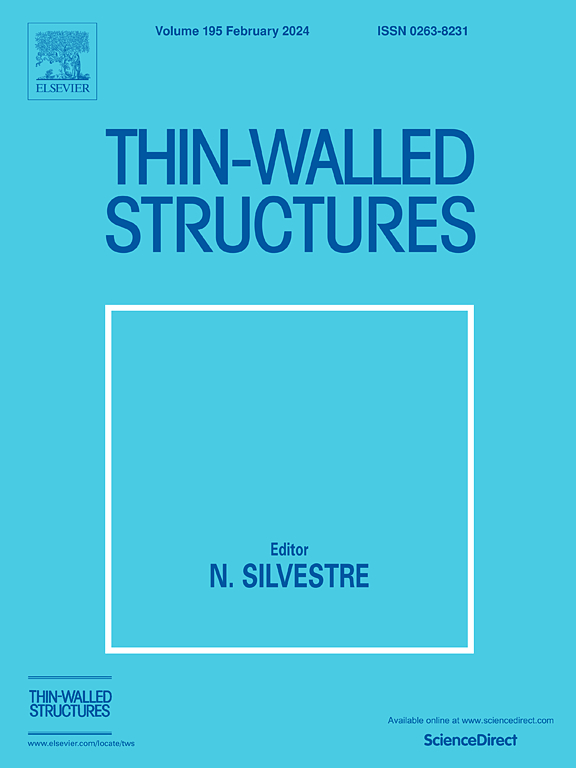Development of self-centring beam-to-column joints with large-dimensional SMA buckling-restrained plates
IF 5.7
1区 工程技术
Q1 ENGINEERING, CIVIL
引用次数: 0
Abstract
This paper presents an innovative self-centring (SC) beam-to-column joint (BCJ) design that utilises shape memory alloy (SMA) plates. The proposed SMA-SC-BCJ is constructed through a straightforward approach using large-scale SMA plates to concentrate inelastic deformation and achieve SC capability. This paper first introduces the components and configuration of SMA-SC-BCJ, followed by the development of a refined finite element model for simulations. Validation against previous experiments verifies the model accuracy in capturing joint behaviour. The analysis shows SMA-SC-BCJ exhibits desirable flag-shaped hysteretic behaviours with excellent SC capability, achieving approximately 92 % recovery alongside moderate energy dissipation. Substantial inelastic deformation localises in the SMA fuse plate due to joint rocking, with minimal plastic strain around the rocking centre. Parametric studies on shear element construction, bolt pretension levels and beam gap distances provide additional insights into the joint design. The proposed design meets the objectives for a minimal-damage beam-to-column joint with simple construction. The SMA-SC-BCJ design recommendations are presented on the basis of performance assessments, elucidating the effectiveness of the system. This work contributes an innovative seismic-resistant joint solution that advances the emerging practices towards resilient structures.
利用大尺寸 SMA 屈曲约束板开发自定心梁柱连接件
本文介绍了一种利用形状记忆合金(SMA)板的创新型自聚能(SC)梁柱连接(BCJ)设计。所提出的 SMA-SC-BCJ 是通过使用大型 SMA 板来集中非弹性变形并实现 SC 功能的简单方法构建的。本文首先介绍了 SMA-SC-BCJ 的组件和配置,然后开发了用于模拟的精细有限元模型。根据以前的实验进行验证,证实了模型在捕捉接头行为方面的准确性。分析表明,SMA-SC-BCJ 具有理想的旗形滞后行为和出色的 SC 能力,在适度能量耗散的同时,还能实现约 92% 的恢复。由于接头摇摆,大量非弹性变形集中在 SMA 熔丝板上,摇摆中心周围的塑性应变极小。对剪切元件结构、螺栓预拉力水平和梁间隙距离进行的参数研究为接头设计提供了更多启示。所提出的设计满足了以简单的结构实现最小损伤的梁柱连接的目标。在性能评估的基础上提出了 SMA-SC-BCJ 设计建议,阐明了系统的有效性。这项工作提供了一种创新的抗震连接解决方案,推动了抗震结构的新兴实践。
本文章由计算机程序翻译,如有差异,请以英文原文为准。
求助全文
约1分钟内获得全文
求助全文
来源期刊

Thin-Walled Structures
工程技术-工程:土木
CiteScore
9.60
自引率
20.30%
发文量
801
审稿时长
66 days
期刊介绍:
Thin-walled structures comprises an important and growing proportion of engineering construction with areas of application becoming increasingly diverse, ranging from aircraft, bridges, ships and oil rigs to storage vessels, industrial buildings and warehouses.
Many factors, including cost and weight economy, new materials and processes and the growth of powerful methods of analysis have contributed to this growth, and led to the need for a journal which concentrates specifically on structures in which problems arise due to the thinness of the walls. This field includes cold– formed sections, plate and shell structures, reinforced plastics structures and aluminium structures, and is of importance in many branches of engineering.
The primary criterion for consideration of papers in Thin–Walled Structures is that they must be concerned with thin–walled structures or the basic problems inherent in thin–walled structures. Provided this criterion is satisfied no restriction is placed on the type of construction, material or field of application. Papers on theory, experiment, design, etc., are published and it is expected that many papers will contain aspects of all three.
 求助内容:
求助内容: 应助结果提醒方式:
应助结果提醒方式:


